Tea in October
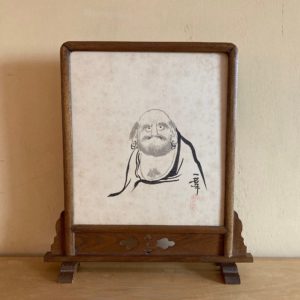
The writing is derived from the alleged incident of Daruma traveling in China, and crossing a river on a stalk of grass; ichi-i to-kō, 一葦渡江 , one-reed cross-inlet. The red ink stamp is a bit of a mystery, as it is a bit obscured. It appears to read, kake-maki, 掛巻, hang-wrap, which, if it is truly that reading, what does it mean? Was it destined to be made into a hanging scroll, and if so, how easily would it be to get rid of the red ink stamp? Often artists would paint a picture of Daruma, and have a Buddhist priest write something identified with the Zen master on the remainder of the painting.

The above picture is of seki-iri, 席入, room-into, entry into the Tearoom as seen from the guests’ entrance. The Tearoom is darkened as the light through the windows, which are often quite small, are shaded by the sudare that are hung over them on the outside. For a simple Tea presentation, there are two essential things that should be present in the cha-seki, 茶席, tea-room: the kake-mono, 掛物, hang-thing, in the toko-no-ma, 床の間, floor-’s-room, and the hearth, the furo and kama, 釜, kettle, or in the cold half of the year, the ro, 炉, (sunken) hearth and kama. An essential aspect of the kakemono is the word, and as the spoken word is incorporeal, it is Yō, 陽, positive, penetrative. The essential aspect of the furo is the fire, which is Yō. The furo also embodies the Go-gyō, 五行, Five-transitions, five physical elements of earth, water, fire, metal, and wood. The most essential element of the Tea presentation, aside from the tea, is hot water for the tea. Because fire poses danger if left unattended, it is necessary to have it present in the room. Fire is the center of the world.

Kake-mono, 掛物, hang-thing, with calligraphy, ‘Hi-bi kore kō-jitsu’, 日々是好日, Day-day is good-day. Buddhist reading is nichi nichi kore kō nichi. Chinese: ri ri shi hao ri. and jih jih shih hao jih.
Calligraphy by Ō-nishi Ryō-kei, 大西良慶, Great-west Good-delight, 1875-1983, chief priest of Kiyo-mizu-dera, 清水寺, Pure-water-temple, Kyōto. Born in Nara in 1875, died in 1983.
Signed at left, Kiyo mizu dera hon zon ryō kei, with hanko, 清水寺本尊良慶, Pure water temple true lord Good-delight, Ichi-mon-ji, 一文字, one-letter-character, and fū-tai, 風帯, wind strap, Kara-kusa kin-ran, 唐草, Tang-grass gold-brocade, on white cloth. Chū-mawashi, 中廻し, middle-surround – blue don-su, 緞子, damask-of. Ten-chi, 天地, heaven-earth, brown silk. Jiku, 軸, scroll, black-lacquered wood.
Length: 5.28 shaku kane-jaku, 63 inches – 160.5 cm. Width: 1 shaku kane-jaku. With box made of momi, 樅, fir.
Chinese: ri ri shi hao ri. and jih jih shih hao jih.
The expression is included in the Heki-gan-roku, 碧巌録, Blue-cliff-record. Case 6: Yun-men’s “Good Day,” Yun-men, 雲門, Cloud-gate, giving instructions, said “I don’t ask you about before the fifteenth day; bring me a phrase about after the fifteenth day.” Yun-men himself answered instead of the monks, “Every day is a good day.” The great Chinese Zen priest, Yun-men, Cloud-gate, (864? – 949). In Japanese he is called Unmon.
Ōnishi Ryōkei was one of the most important and colorful Buddhist priests of the 20th century. For years he lived as a semi-hermit in the mountains of Kyōto while serving as abbot of Kiyomizu-dera, which is perhaps the most famous temple in Japan. Ryōkei each day commuted miles on foot to Kiyomizu. He was an outstanding scholar, an excellent artist, and a stimulating speaker. In his late 80’s Ryōkei surprised everyone by marrying a young woman and promptly fathering two children. Ryōkei remained active right up to his death in 1983 at the age of 108. 108 is an extraordinarily important number especially in Buddhism.
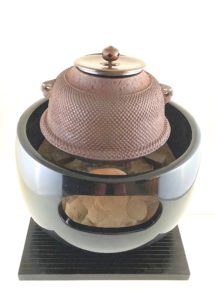
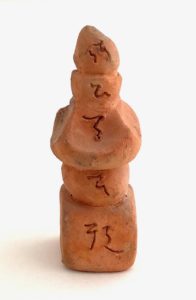
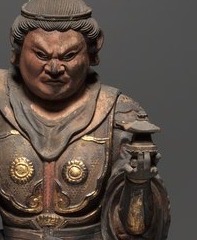
As a monument of the Gogyō, the furo and kama are also identified with the Go-rin-tō, 五輪塔, Five-ring-tower, the reliquary of the Buddha. The Gorintō is symbolic of the five principles: Chi-rin, 地輪, Earth-ring, Sui-rin, 水輪, Water-ring, Ka-rin, 火輪, Fire-ring, Fū-rin, 風輪, Wind-ring, Kū-rin, 空輪, Void-ring. This is also called a Hō-tō, 宝塔, Treasure-tower. According to the Eki-kyō, Chinese I Ching, 易経, Change-sutra, the furo/kama establishes the north direction.
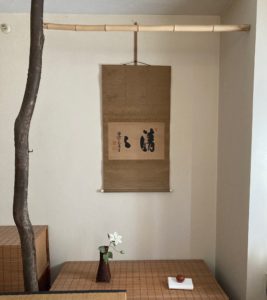
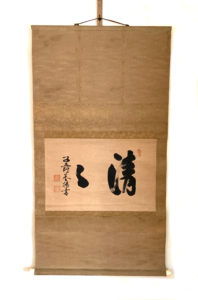
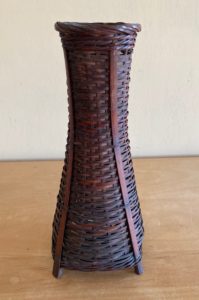
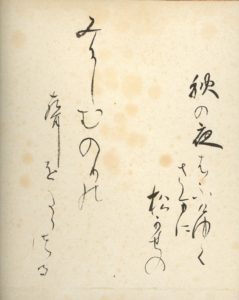
Shiki-shi, 色紙, color-paper, with calligraphy:
Aki no yo o fuke yuku sama ni matsukaze no mi shi mu nori no koe o kikitsuru.
秋の夜をふけゆくさまに松かぜのみにしむのりの声をききつる。
Autumn ’s evening o as it advances in chill pine wind body in sinks law’s voice is heard.
Myō-e Shō-nin, 明恵上人, Bright-blessing Upper-person, 1173 – 1232
The calligraphy on the above shikishi was written by O-gawa Ryō, 小川, Little-river Goodness, the wife of O-gawa Gisshō , 小川義章, Little-river Righteous-badge, the abbot of Kō-san-ji, 高山寺, High-mountain-temple, Toga-(no)-o, 栂尾, Hemlock-’s-tail, Kyōto.

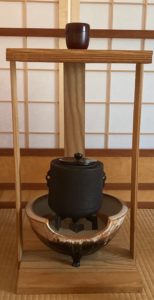
The display stand was made of a fruit crate dismantled and re-assembled as a display stand modeled after the Go-gyō dana, 五行棚, Five-transitions shelf, created by Gen-gen-sai, 玄々斎, Mystery-mystery-abstain, XI Iemoto, Urasenke. The name is derived from the presence of the furo and kama, which manifest the Go-gyō, which are five physical elements: Moku Ka Do Gon Sui. Moku, 木, Wood, spring. Ka, 火, Fire, summer. Do, 土, Earth, center. Gon, 金, Metal (Gold), autumn. Sui, 水, Water, north.
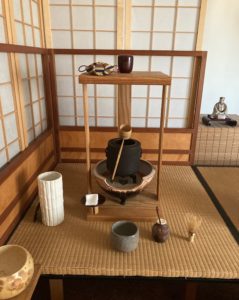
Having a furo in the middle of the tatami is a very old tradition, and may have been one of the original locations. Besides being a heater for a kettle of hot water, the furo is also an incense burner, as incense, most often byaku-dan, 白檀, white-sandalwood, is put into the fire.
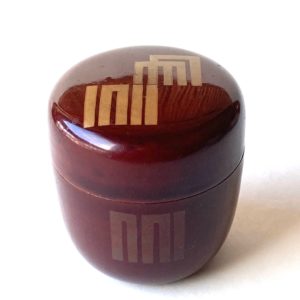
Natsume, 棗, jujube;maroon-lacquered, ovoid covered container with various colors of gold designs of,Genji Kō no Zu, 源氏原香の図, Origin-clan Incense’s Motifs, Gen-gen-sai Konomi, 玄々斎好み, Mystery-mystery-abstain choice, XI Iemoto, Urasenke, Japan: H. 1.8 sun kujira-jaku.
Chapter motifs: lid far side, Su-ma, 須磨, Necessary-polish, lid near side, Aka-shi, 明石, Bright-stone; front, Matsu-kaze, 松風, Pine-wind; guest, Sakaki,榊, (Japanese) cleyrea; back, Azuma-ya, 東屋, East-house (red).
Na-gori–cha, 名残茶, name-remain-tea, the tea remaining from the past year is served, in anticipation of the opening of the ro and the new tea.
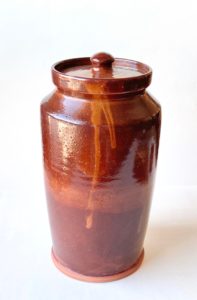
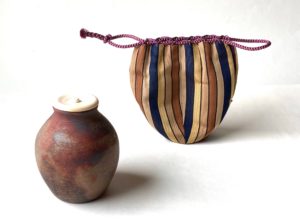
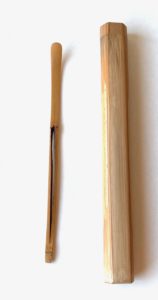
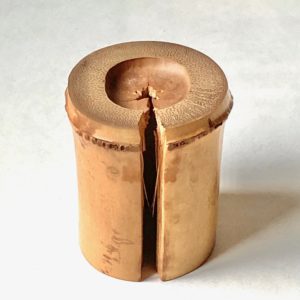
Although a tana is used in this tenmae, because the mizusashi is carried in and out of the room the futaoki should be made of bamboo. However, in the 10th month, ao-dake, 青竹, green-bamboo, is not used. Aged and somewhat shabby in appearance is appropriate for the decline of the autumn.
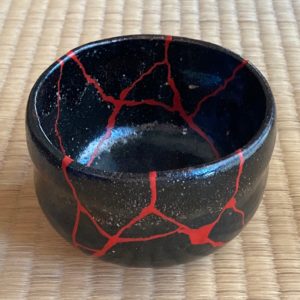
This bowl, without history, I took to Jerusalem, and made Tea for friends in the garden of Gethsemane. Later, it was used to make Tea at the opening of an exhibition of the paintings by Paul Nagano at the Art Complex Museum in Duxbury, Massachusetts. I presented Chanoyu at the museum’s Chashitsu over forty years. Later, when I opened the box to look at it, I discovered that it had broken into many pieces. I had it repaired in Kyōto with red lacquer rather than gold.
In the month of October, utensils that have been broken and repaired or that have a worn and ages appearance, are used to reflect the decline of the autumn season. If every utensil has a distressed quality, the overall effect is ‘dirty’. Therefore, something bright, colorful, new, shiny, etc. should be used to create a feeling of wabi, 侘. Wabi is derived from the contrast between different things.
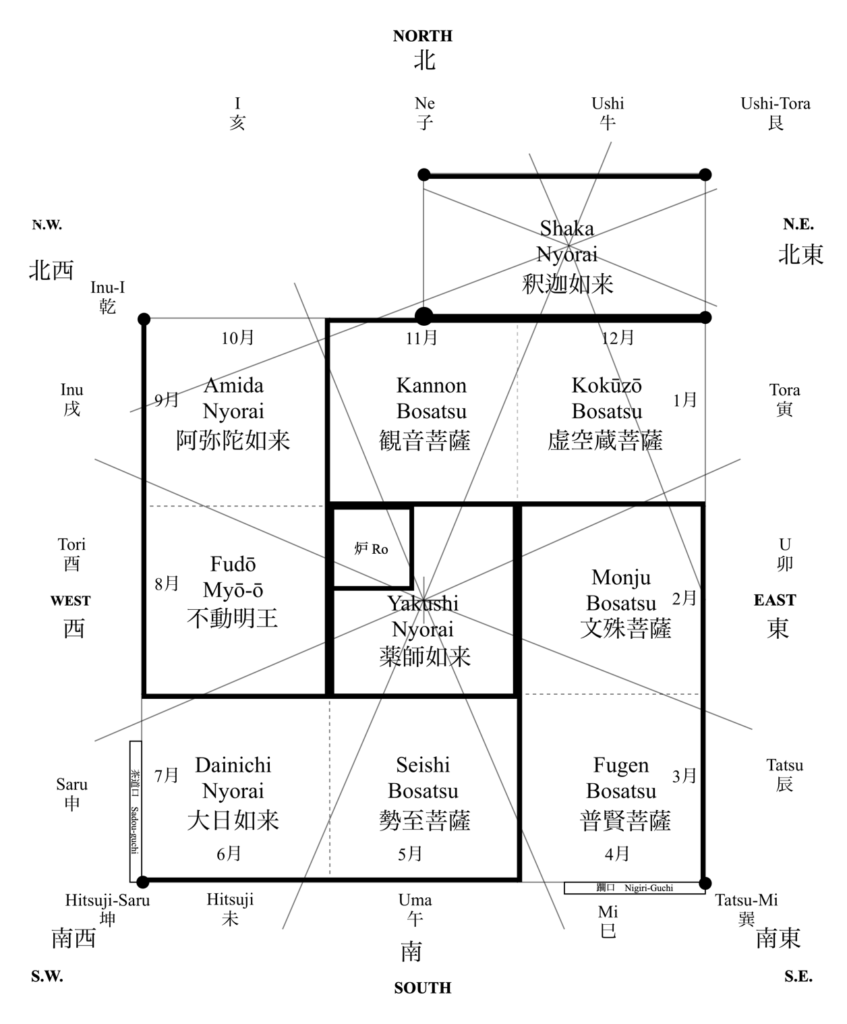
The 10th lunar month, Jū-gatsu, 十月, Ten-moon, in the yo-jō-han, 四畳半, four-mat-half, is located in the northwest corner of the room. The northwest is marked with two zodiac signs, Inu and I, 戌亥, Dog-Boar, which is written Inu-I, 乾, drought, dry, desiccate, drink up, heaven, emperor, etc. The Kanji is also read Ken, which is identified with the divination sign, Ken, of the I Ching, Eki-kyō, 易経, Change-sutra.
The 10th lunar month is identified by the zodiac sign Inu, 戌, Dog, and the 11th lunar month are protected by A-mi-da Nyo-rai, 阿弥陀如来, Praise-increase-steep Like-become, the Buddhist Buddha of Compassion. Amida is especially revered on the day of the full moon. In the
Amida in his act of Rai-go, 来迎, Come-welcome, approaches to guide souls to his paradise in the west called Goku-raku Jō-do, 極楽浄土, Ultimate-pleasure Pure-land. He is accompanied by Kan-non Bo-satsu, 観音菩薩, See-sound Grass-buddha, and Sei-shi Bo-satsu, 勢至菩薩, Strength-attain Grass-buddha. In the diagram of the yojōhan, Kannon is located in the north, and Seishi is in the south, theoretically approaching with Amida from the northwest to greet the guests located in the east.
The guests at a Tea ceremony are metaphorically located between the earthly world and the spirit world, which is manifested in the yojōhan. The floor of the yojōhan, like most traditional Japanese architecture, is elevated from the ground. The guests sit in the east side of the room facing west, the realm of Amida. The teishu prepares Tea while seated in the west, and as the host is identified with Fu-dō Myō-ō, 不動, Not-move Bright-king.
The Tea utensils and the preparation of Tea are located in the northwest corner of the room, which is identified with the Ekikyō sign for Ken, 乾, Heaven.
Amida forsook attaining the ultimate divinity until every soul has attained enlightenment, and made 48 vows. The most important may be his 18th vow, called ‘Amida’s Hon-gan’, 本願, Original-vow.
Amida’s 18th Vow:
If, when I attain Buddhahood, the sentient beings of the ten quarters who, with sincere and entrusting heart, aspire to be born in my land and say my name even ten times, should not be born there, may I not attain the perfect enlightenment. Excluded are those who commit the five grave offenses and *those who slander the right Dharma.
Furo season ends at the end of the 10th month, and the ro season begins near the start of the 11th month. A line drawn on the yojōhan diagram from where the 10th and 11th months meet to where the 4th and 5th months meet, divides the furo and ro seasons. The line passes to the east of the ro and the kama. The influence of the eight Buddhist deities extends from the very center of the yojōhan. This places the ro kama in the place that is protected by Amida. Perhaps not by coincidence, one of Rikyū’s preferred kama was the Amida-dō gama.
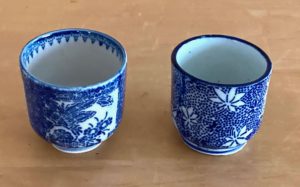
The two cups pictured were made perhaps in the early part of the 20th century, were decorated with stenciled patterns, which is less expensive that hand-painting. Nonetheless, the technique requires considerable effort and skill. An unusual feature of such cups is a wider than usual kō-dai, 高台, ring-support, foot.
Hot water and tea are offered daily to departed Buddhist souls in private homes as well as temples, and perhaps with deeper conviction during more solemn times. During Kan-na-zuki, 神無月, God-no-month, the Godless Month, Shintō deities leave their usual shrines, and assemble at the ancient shrine in Izumo, leaving the Buddhist deities and souls in their accustomed places.
October 5th is Daru-ma-ki, 達磨忌, Attain-polish-memorial, observances are held on the date of the death of Bodhidharma. The cause of his death is obscure, but it was thought that he was poisoned by jealous opponents. Daruma founded Zen Buddhism in China, and meditated for nine years facing a wall. He lost the use of his legs, but continued to sit upright no matter the situation.
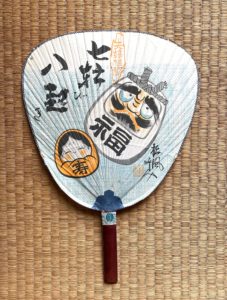
The outline of the uchiwa is in the stylized shape of Daruma: full length of the fan is 13.5 sun kane-jaku; length of the papered section is 9.5 sun kane-jaku, length of the handle is 4 sun kane-jaku. However, the exact, full length measurement may be with the kujira-jaku, as the full length is 10.8 sun kujira-jaku. Hyaku-hachi, 百八, hundred-eight, 108 is a number of deep symbolic significance. It is thought that human beings are subject to 108 desires that must be dispelled to attain enlightenment.
